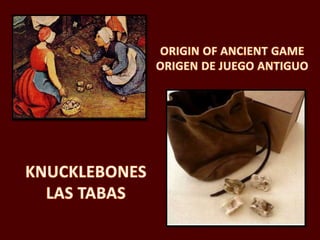
Origin of Ancient Game: Knucklebones. Origen de juego antiguo: Las tabas
- 2. One of the most widely played children’s games has been around since time immemorial: knucklebones. It was originally played with five ‘knucklebones’ of a sheep, and the rules are simple. The child throws the bones in the air and catches them, usually on the back of the hand, in a series of prescribed throws and catches. The child that’s the first to manage the full set of throws in a row, wins. Uno de los juegos más popular de los niños que ha existido desde tiempos inmemoriales: Las tabas. Se jugó originalmente con cinco "tabas" de una oveja, y las reglas eran simples. El niño lanza al aire los huesos y los atrapa, por lo general con la parte posterior de la mano, en una serie regulada de lanzamientos y capturas. El niño que consigue primero la totalidad de los tabas en un lanzamiento, gana.
- 3. A 1734 painting depicting a girl playing knucklebones.
- 4. Sophocles, for instance, ascribes the invention to Palamedes during the Trojan War, while in another legend Zeus is said to have presented Ganymede with both a new playmate (Eros) and a set of gold dibs for them to play with. On the other hand, Plato mentions the game as having been invented by the Egyptian god Toth, while Herodotus tells us the Lydians created it during a period of famine. Sófocles, por ejemplo, atribuye la invención a Palamedes durante la guerra de Troya, mientras que en otra leyenda, Zeus, se dice que presentó a Ganímedes con un nuevo compañero de juegos (Eros) y un juego de tabas de oro con el que jugar. Por otra parte, Platón, menciona el juego como si hubiera sido inventado por el dios egipcio Toth, mientras que Heródoto nos cuenta que los lidios, lo crearon durante un período de hambruna. Ganymede Lydians
- 5. Other names for knucklebones include astragaloi, dibs, and chuckstones.
- 6. Escultura de una niña de la antigua Roma jugando a las tabas (130-150 aC). Los romanos heredaron la costumbre griega de jugar con tabas (tali en latín, astragaloi en griego). Sin embargo, los juegos con tabas no tuvieron tanta preponderancia en la cultura romana como en la griega, porque fueron parcialmente substituidos por los dados (Tesserae). Sculpture of a girl of ancient Rome playing knucklebones (130-150 BC). The Romans inherited the Greek habit of playing with knucklebones (tali in Latin, astragaloi in Greek). However, playing with knucklebones were not so preponderance in Roman culture as in Greek, because they were partially replaced by the dice (Tesserae).
- 7. Greece, Hellenic Period, c. 500 BC., a lot of 3 bronze weights all in the form of an astragaloi or knucklebones. Grecia, Periodo Helénica, c. 500 aC., Una colección de 3 tabas de bronce toda en la forma de un astrágalo o taba.
- 8. Jogo do osso (juego del hueso). Xilograbado de Glênio Bianchetti (1955).
- 9. Four astragaloi were used and a total of 35 different scores were possible in a single throw. Many of these throws received distinctive names such as: Aphrodite, Midas, Solon, and Alexander. Among the Romans, some of the names were: Venus, King, Vulture, etc. Cuatro tabas se utilizaron y un total de 35 diferentes puntuaciones eran posibles en un solo lanzamiento. Muchos de estos lanzamientos recibieron nombres distintivos tales como: Afrodita, Midas, Solón y Alexander. Entre los romanos, algunos de los nombres eran: Venus, el rey, Buitre, etc.
- 15. Argentina
- 16. “Sagrada Familia” de Antoni Gaudi
- 17. Argentina
